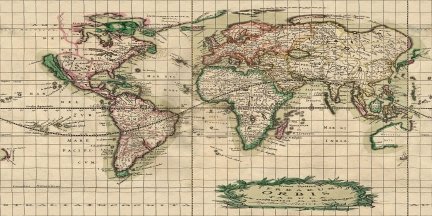Marble/HistoricalMaps/WorldMapSchagen1689: Difference between revisions
< Marble | HistoricalMaps
No edit summary |
No edit summary |
||
| (7 intermediate revisions by 2 users not shown) | |||
| Line 1: | Line 1: | ||
====Historical World Maps: G. van Schagen (1689)==== | ====Historical World Maps: G. van Schagen (1689)==== | ||
[[Image:schagen1689_orig_thumb.jpg|frame|none|Source: [http://commons.wikimedia.org/wiki/Image:World_Map_1689.JPG World Map 1689], Wikimedia Commons, License: Public Domain]] | [[Image:schagen1689_orig_thumb.jpg|frame|none|'''Source File''': [http://commons.wikimedia.org/wiki/Image:World_Map_1689.JPG World Map 1689], Wikimedia Commons, License: Public Domain]] | ||
[[Image:schagen1689_reprojected_thumb.jpg|frame|none|[http://developer.kde.org/~tackat/history/World_Map_1689.jpg | |||
[[Image:schagen1689_reprojected_thumb.jpg|frame|none|'''Reprojected File:''' [http://developer.kde.org/~tackat/history/World_Map_1689.jpg Reprojected World Map 1689] (full size 3.8 MB). Reprojected by Magnus Valle to plate carrée projection. Touched up by Torsten Rahn, License: Public Domain]] | |||
====About the Author==== | |||
[http://www.atlasandmap.com/carto/list.php?cart=s Gerrit Lucasz. van Schagen]: Amsterdam, 1642-ca. 1690, engraver, art dealer | |||
====Interesting Aspects==== | ====Interesting Aspects==== | ||
* In China you can spot the chinese wall. | * In China you can spot the ''chinese wall''. | ||
* Where can you see New York on this map (look for New Amsterdam)? | * Where can you see New York on this map (look for New Amsterdam)? | ||
* The map shows California as an island (which was a common misconception at that time which also was depicted in other maps). | * The map shows ''California as an island'' (which was a common misconception at that time which also was depicted in other maps). | ||
* What are the names of Australia and Tasmania on this map? | * What are the names of Australia and Tasmania on this map? | ||
* On the map Greenland is apparently not a separate island. Instead it's depicted as part of the north american mainland. | * On the map Greenland is apparently not a separate island. Instead it's depicted as part of the north american mainland. | ||
| Line 19: | Line 24: | ||
* The map shows a region called "Nova Dania" ( "New Denmark", see also [http://en.wikipedia.org/wiki/Jens_Munk Jens Munk] ) | * The map shows a region called "Nova Dania" ( "New Denmark", see also [http://en.wikipedia.org/wiki/Jens_Munk Jens Munk] ) | ||
* Where on the map is the Caspian Sea located? How does its size and shape compare to the Caspian Sea on modern maps? How did the size of the Caspian Sea change during the last 100 years? What was the size during the ice age? Is it likely that the Caspian Sea ever had the size and the shape such as depicted on the Schagen map (to find out you might want to have a look at the topographic map ...)? Search for "Derbent" on a modern map and then on the Schagen Map. | |||
Revision as of 13:38, 17 December 2008
Historical World Maps: G. van Schagen (1689)


About the Author
Gerrit Lucasz. van Schagen: Amsterdam, 1642-ca. 1690, engraver, art dealer
Interesting Aspects
- In China you can spot the chinese wall.
- Where can you see New York on this map (look for New Amsterdam)?
- The map shows California as an island (which was a common misconception at that time which also was depicted in other maps).
- What are the names of Australia and Tasmania on this map?
- On the map Greenland is apparently not a separate island. Instead it's depicted as part of the north american mainland.
- The Prime Meridian is shifted by 20 degrees to the west compared to today's standards.
- The map seems to be globally pretty accurate in terms of shape. For Europe, Africa and much of America the geographic coordinates match surprisingly well, however it's noticably off for the eastern hemisphere.
Details:
- The map shows a region called "Nova Dania" ( "New Denmark", see also Jens Munk )
- Where on the map is the Caspian Sea located? How does its size and shape compare to the Caspian Sea on modern maps? How did the size of the Caspian Sea change during the last 100 years? What was the size during the ice age? Is it likely that the Caspian Sea ever had the size and the shape such as depicted on the Schagen map (to find out you might want to have a look at the topographic map ...)? Search for "Derbent" on a modern map and then on the Schagen Map.
